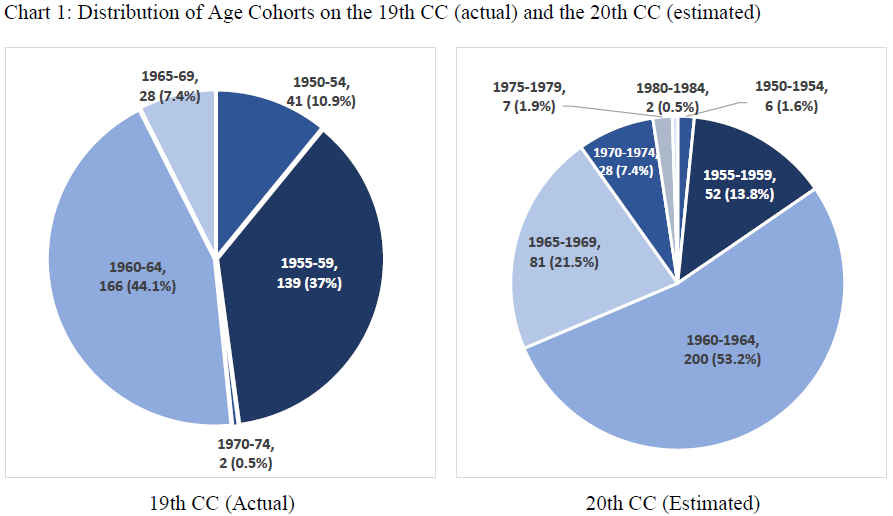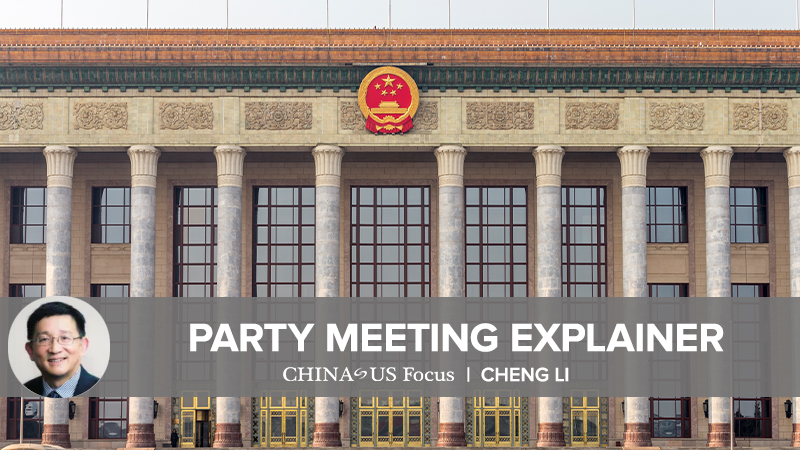If the 19th Congress of the Chinese Communist Party (CCP) in 2017 presented the coming-of-age of the post-1960s generation (6G) at the ministerial and provincial levels of the Chinese leadership, the forthcoming 20th Party Congress will witness the rise to predominance of this age cohort in the top national leadership. Although Xi Jinping and a few other post-1950s generation (5G) leaders will remain in a few top positions, the post-1960s age cohort is expected to become a majority of the 25-member Politburo and other prominent leadership bodies.
Several 6G leaders –– for example, Director of the CCP General Office Ding Xuexiang (1962), Vice Premier Hu Chunhua (1963), and Chongqing Party Secretary Chen Min’er (1960) –– will be top contenders for the seven-member Politburo Standing Committee (PSC), the highest decision-making body in China, which currently consists exclusively of 5G leaders. These 6G leaders, along with a few who were born in the late 1950s –– for example, Shanghai Party Secretary Li Qiang (1959) –– are in line for top national leadership positions in the 20th Party Congress, following behind only Xi Jinping and a couple of others.
Although the official line of CCP authorities does not emphasize the terms 5G or 6G nowadays, observers in both China and abroad pay great attention to these generational identities and their implications for future political succession. Of course, there is neither a sign that Xi Jinping intends to retire after his third term in 2027 nor any indication that he will designate a successor at the 20th Party Congress this fall. This is, however, precisely the reason it is important to analyze a broader group of potential contenders for power, especially among 6G leaders who will soon dominate the national leadership.
Each generation of leaders carries a distinct blend of experiences in terms of collective memory, personal socialization, political networking, career paths, educational and professional credentials, and administrative background. Evaluating these traits may offer clues as to how 6G leaders differ from the preceding generation in their worldviews, policy preferences, and political trajectory. A better understanding of this age cohort is crucial for students of Chinese elite politics, especially at a time when China confronts a rapidly changing international environment resulting from Russia’s horrific invasion of Ukraine and the arrival of a potentially devastating new Cold War.
Preoccupation with generational identities in Chinese elite politics
Political leaders in a given country usually are not limited exclusively to political elites from the same generation. In post-Mao China, the national leadership has often consisted of elites across two or even three generations. The concept and categorization of elite generations are often political; and as some sinologists have observed, it is rather arbitrary to define “where one generation begins and another ends.”
In reform-era China, the categorization of political elite generations –– including the Long March generation (1G), the Anti-Japanese War generation (2G), the Socialist Transformation generation (3G), and the Cultural Revolution generation (4G) –– has become a crucial factor in leadership transition and political succession within the CCP. The generational categories have largely been shaped by the political considerations of top leaders such as Deng Xiaoping and Jiang Zemin. It was Deng who initiated the generational terminology in the early 1990s. By identifying himself as the “core” of the second generation and Jiang as the “core” of the third generation, Deng hoped to foster a smoother political transition in the wake of the failed ascensions of Hu Yaobang and Zhao Ziyang, who had been previously anointed to succeed him. Jiang was more than ready to use generational identity to consolidate his political legitimacy as heir to Deng.
Both 4G and 5G Chinese leaders can be regarded as the Cultural Revolution generation. Both 4G top leader Hu Jintao and 5G top leader Xi Jinping had their most important formative experiences during the Cultural Revolution. However, the informal subdivision within the Cultural Revolution generation has extended the rule of political leaders who experienced their most formative years during the different periods of that turbulent decade.
The boundaries of political elite generations are highly political and often subject to change. This explains the recent change in the Chinese definition of political elite generations based on the decade in which one was born –– with 5G now referring to those born in the 1950s and 6G referring to those born in the 1960s. More importantly, one generation’s rule can be either prolonged or bypassed. For analysts, this further amplifies the significance of the composition of age cohorts in the CCP leadership.
Growing prominence of 6G leaders
Apart from a few 5G leaders at the pinnacle of power, the leaders of the post-1960s generation will complete their full-fledged transition to power at the upcoming 20th Party Congress. Empirical data show that 6G leaders increased from 18.6 percent of 18th Central Committee (CC) to 51.5 percent of the 19th CC, and are currently on trajectory to increase further to about 75 percent of the 20th CC.
Chart 1 presents the distribution of age cohorts on the 19th CC (actual) and the 20th CC (estimated). Given that many 5G members on the current CC have already retired or moved to more ceremonial positions, one can reasonably forecast that only a handful of leaders from the 1950-1954 age cohort will remain on the 20th CC. Furthermore, the 1955-1959 age cohort is expected to drop from 37 percent to about 14 percent. Altogether, 5G leaders will likely only constitute approximately 15 percent of the next CC.

Source: Cheng Li, Brookings Institution.
The 19th CC has only two members (both with alternate status) who were born in the 1970s. The presence of 7G leaders on the next CC is expected to increase significantly, but they will likely constitute less than 10 percent of the body. It is not entirely clear whether there will be any 8G representatives on the 20th CC. If so, their presence will be just symbolic, as was the case with the two 7G members on the 19th CC. The predominance of 6G leaders on this important body cannot be overstated. Xi’s future successor will most likely emerge from among the 6G leaders.
Presently, 47 (76 percent) provincial chiefs (Party secretaries, governors, and mayors) are from the post-60s generation. Among the members of the provincial Party standing committees that have completed reshuffling, 81 percent were born in the 1960s. In comparison, in 2015, only 40 percent of these provincial Party standing committee members were born in the 1960s.
In the military leadership, among the commanders and commissars of the six forces (army, navy, air force, rocket force, strategic support force, and armed police), all except one (Air Force Commissar Yu Zhongfu, 1956) were born in the 1960s. The Chinese military has long prioritized seniority in determining officer promotions. Thus, senior-level officers typically belong to the same age cohort. None of the 41 military leaders with full membership on the 18th CC, for example, belonged to the 6G. But Xi Jinping’s large-scale military reforms in recent years have promoted many “young guards.” From July 2021 to January 2022, as chairman of the Chinese Military Commission (CMC), Xi granted the rank of full general to 16 military officers, and all of them are part of the 6G cohort. One can reasonably expect that 6G leaders will predominate the military representatives in the 20th CC. It remains unknown whether any will enter the powerful CMC this fall.
The formative experience of 6G leaders
Born between 1960-1969, the 6G leaders were part of China’s baby boomer generation. They were between 9 and 18 years old in 1978 when Deng began economic reform, between 20 and 29 during the 1989 Tiananmen Incident, and now are between 53 and 62. Most members of this generation were too young to participate in the violent and radical Cultural Revolution (CR). Unlike the previous generation, which suffered from famine and hunger during Mao’s Great Leap Forward and radical socialist transformation, members of the 6G typically have had far less personal experience with poverty and starvation.
The oldest members of the 6G were only 16 years old when the CR ended in 1976. Very few of them were CR “sent-down youths” (primarily 5G), who lost the chance to attend formal school for elementary or middle school education. Instead, many 5G leaders worked as farmers in impoverished rural China for the better part of their teenage years. The majority of 5G leaders experienced great physical hardship as sent-down youths, which arguably nurtured within them valuable traits such as adaptability and endurance. As of early 2021, more than half of the provincial Party secretaries had served as sent-down youths. They all worked for many years in some of the poorest rural areas in China.
Therefore, the life experiences of 5G and 6G leaders differ profoundly. But 6G leaders did not have the fortune, like the following generations, to enjoy a middle-class or affluent life in their formative years. However, during their formative years in secondary school and college in the 1980s, 6G leaders had the opportunity to enjoy the beginning of Deng’s economic reform and opening, arguably the most liberal period in PRC history. In the 1980s, for example, there were several nationwide debates among Chinese youth on the lessons of the CR, the issues with individualism, the problems of conformity and uniformity, and the new spirit of the special economic zones. Whether or not 6G leaders studied in China and abroad, they were strongly influenced by the West.
The Tiananmen incident was undoubtedly the most important political event in the collective memory of those born in the 1960s, as this consequential event was their defining political experience. No matter what side they were on or what lessons they learned during this tragic short period of turmoil, they all matured politically because of the experience. One may reasonably assume that, having undergone their formative years during this period of drastic political change, China’s 6G leaders will have more diverse political views and values than 5G leaders.
Contrasting educational attainment between 5G and 6G leaders
Typically, 6G leaders attended college immediately after high school. Many of them took the first national examination for college admission in 1978 after Deng reinstituted this mechanism that was abandoned during the CR. For example, many provincial Party secretaries, including Chongqing Party Secretary Chen Min’er (1960), Zhejiang Party Secretary Yuan Jiajun (1962), Shaanxi Party Secretary Liu Guozhong (1962), Hunan Party Secretary Zhang Qingwei (1961), Jilin Party Secretary Jing Junhai (1960), Shanxi Party Secretary Lin Wu (1962), Heilongjiang Party Secretary Xu Qin (1961), and Guangxi Party Secretary Liu Ning (1962), all belong to the famous class of 1978. Most of them majored in engineering.
According to a Chinese study in 2012, among the post-1960s provincial and ministerial-level leading cadres, nearly 90 percent have postgraduate degrees. In general, 6G officials had a well-rounded educational experience. They had more exposure to the West through foreign instructors or educational experience through studying abroad than 4G and 5G leaders.
In contrast, the formal elementary and secondary schooling of 5G leaders was severely interrupted by the CR. Some of them entered college as “worker, peasant, and soldier students” who were chosen to enroll in higher education during the CR, based largely on their political background rather than their academic credentials. Some 5G leaders attended college after the national college entrance examination resumed in 1978 when they were already in their late 20s and early 30s. Still, others attended part-time programs or studied mainly in the Central Party School.
Collectively, generational differences in educational experience may lead to widely differing leadership capacity, administrative skills, behavioral attributes, and even policy orientations among China’s future leaders. The following articles will aim to shed valuable light on these important issues.

